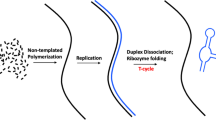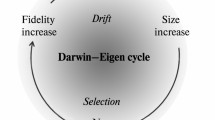Summary
If protein synthesis evolved in an RNA world it was probably preceded by simpler processes by means of which interaction with amino acids conferred selective advantage on replicating RNA molecules. It is suggested that, at first, the simple attachment of amino acids to the 2′(3′)-termini of RNA templates favored initiation of replication at the end of the template rather than at internal positions. The second stage in the evolution of protein synthesis would probably have been the association of pairs of charged RNA adaptors in such a way as to favor noncoded formation of peptides. Only after this process had become efficient could coded synthesis have begun.
Similar content being viewed by others
References
Acevedo OL, Orgel LE (1987) Non-enzymatic transcription of an oligodeoxynucleotide 14 residues long. J Mol Biol 197: 187–193
Benner SA, Allemann RK, Ellington AD, Ge L, Glasfeld A, Leanz GF, Krauch T, MacPherson LJ, Moroney S, Piccirilli JA, Weinhold E (1987) Natural selection, protein engineering, and the last riboorganism: rational model building in biochemistry. Cold Spring Harbor Symp Quant Biol LII:53–63
Brack A (1984) Prebiotic synthesis and organization of biopolymer-like macromolecules. Origins Life 14:229–236
Brack A, Orgel LE (1975) β structures of alternating polypeptides and their possible prebiotic significance. Nature 256: 383–387
Cech TR (1987) The chemistry of self-splicing RNA and RNA enzymes. Science 236:1532–1539
Crick FHC (1968) The origin of the genetic code. J Mol Biol 38:367–379
Crick FHC, Brenner S, Klug A, Pieczenik G (1976) A speculation on the origin of protein synthesis. Origins Life 7:389–397
Fox SW (1978) The origin and nature of protolife. In: Heidcamp WH (ed) The nature of life, XIIIth Nobel Conference. University Park Press, Baltimore, pp 23–92
Gilbert W (1963) Polypeptide synthesis inEscherichia coli. II. The polypeptide chain and s-RNA. J Mol Evol 6:389–403
Gilbert W (1986) The RNA world. Nature 319:618
Hentzen D, Mandel P, Garel J-P (1972) Relation between aminoacyl-tRNA stability and the fixed amino acid. Biochim Biophys Acta 281:228–232
Hulshof J, Ponnamperuma C (1976) Prebiotic condensation reactions in an aqueous medium: a review of condensing agents. Origins Life 7:197–224
Jay DG, Gilbert W (1987) Basic protein enhances the incorporation of DNA into lipid vesicles: model for the formation of primordial cells. Proc Natl Acad Sci USA 84:1978–1980
Lacey JC Jr, Mullins DW Jr (1983) Experimental studies related to the origin of the genetic code and the process of protein synthesis—a review (see particularly pp 29–40). Origins Life 13:3–42
Lagerkvist U (1978) “Two out of three”: an alternative method for codon reading. Proc Natl Acad Sci USA 75:1759–1762
Lehman N, Jukes TH (1988) Genetic code development by stop codon takeover. J Theor Biol 135:203–214
Lewin R (1986) RNA catalysis gives fresh perspective on the origin of life. Science 231:545–546
Mar A, Dworkin J, Oro J (1987) Non-enzymatic synthesis of the coenzymes, uridine diphosphate glucose and cytidine diphosphate choline, and other phosphorylated metabolic intermediates. Origins Life 17:307–319
Orgel LE (1968) Evolution of the genetic apparatus. J Mol Biol 38:381–393
Orgel LE (1972) A possible step in the origin of the genetic code. Isr J Chem 10:287–292
Profy AT, Usher DA (1984a) Stereoselective aminoacylation of polyribonucleotides. J Am Chem Soc 106:5030–5031
Profy AT, Usher DA (1984b) Stereoselective aminoacylation of a dinucleoside monophosphate by the imidazolides of dl-alanine and N-(tert-butoxycarbonyl)-dl-alanine. J Mol Evol 20:147–156
Samuelsson T, Guindy YS, Lustig F, Boren T, Lagerkvist U (1987) Apparent lack of discrimination in the reading of certain codons inMycoplasma mycoides. Proc Natl Acad Sci USA 84:3166–3170
Schuber F, Pinck M (1974a) On the chemical reactivity of aminacyl-tRNA ester bond. I. Influence of pH and nature of the acyl group on the rate of hydrolysis. Biochimie 56:383–390
Schuber F, Pinck M (1974b) On the chemical reactivity of aminacyl-tRNA ester bond. II. Aminolysis by tris and diethanolamine. Biochimie 56:391–395
Schuber F, Pinck M (1974c) On the chemical reactivity of aminacyl-tRNA ester bond. III. Influence of ionic strength, spermidine and methanol on the rate of hydrolysis. Biochimie 56: 397–403
Sharp PA (1985) On the origin of RNA splicing and introns. Minireview. Cell 42:397–400
Usher, DA, Needels MC (1984) On the stereoselective aminoacylation of RNA. Adv Space Res 4:163–166
Weber AL (1987) Stereoselective formation of a 2′(3′)-aminoacyl ester of a nucleotide. J Mol Evol 25:7–11
Weber AL, Fox SW (1973) Aminoacylation and acetylamino-acylation of homopolyribonucleotides. Biochim Biophys Acta 319:174–187
Weber AL, Lacey JC Jr (1975) Aminoacyl transfer from an adenylate anhydride to polyribonucleotides. J Mol Evol 6:309–320
Weber AL, Orgel LE (1978a) Amino acid activation with adenosine 5′-phosphoimidazolide. J Mol Evol 11:9–16
Weber AL, Orgel LE (1978b) The formation of peptides from the 2′(3′)-glycyl ester of a nucleotide. J Mol Evol 11:189–198
Weber AL, Orgel LE (1979) The formation of dipeptides from amino acids and the 2′(3′)-glycyl ester of an adenylate. J Mol Evol 13:185–192
Weiner AM, Maizels N (1987) tRNA-like structures tag the 3′ ends of genomic RNA molecules for replication: implications for the origin of protein synthesis. Proc Natl Acad Sci USA 84:7383–7387
White HB III (1976) Coenzymes as fossils of an earlier metabolic state. J Mol Evol 7:101–104
Woese CR (1967) The evolution of the genetic code, chapter 7. In: The genetic code. Harper & Row, New York, pp 179–195
Yarus M (1988) A specifie amino acid binding site composed of RNA. Science 240:1751–1758
Zachau HG, Feldmann H (1965) Amino acid esters of RNA, nucleosides and related compounds. Prog Nucleic Acid Res Mol Biol 4:217–230
Author information
Authors and Affiliations
Rights and permissions
About this article
Cite this article
Orgel, L.E. The origin of polynucleotide-directed protein synthesis. J Mol Evol 29, 465–474 (1989). https://doi.org/10.1007/BF02602917
Received:
Revised:
Accepted:
Issue Date:
DOI: https://doi.org/10.1007/BF02602917




